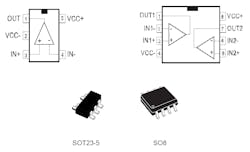Our “Digitized” Cars Still Need Those Precision Op Amps
This article is part of the TechXchange: Exploring Op Amps.
With all of the sophisticated digital circuitry and countless processors in today’s vehicles, regardless of power-plant type or topology, you might think that the “lone rider” operational amplifier would be an analog anachronism with little or no role to play.
If so, then think again, as these most basic analog building blocks are still needed for analog front ends (AFEs) that can deliver precision, low-drift performance even at extended temperatures. Such precision can avoid a lot of drift and signal-chain issues or complex compensation and calibration schemes—and that’s assuming the part even survives to the higher temperatures.
To meet the needs of this well-defined objective, STMicroelectronics introduced the TSZ181H1 (single) and TSZ182H1 (dual) automotive-qualified op amps, delivering high accuracy and stability over a wide −40 to +175°C temperature range. The high maximum-operating temperature facilitates their use in harsh environments and in applications with long mission profiles.
The devices are also AEC-Q100 qualified and have 4-kV human-body-model (HBM) ESD tolerance. (Note that this +175°C rating exceeds even the most stringent AEC-Q100 rating [Grade 0] of +150°C; lower-temperature versions are available.)
The op amps have very low input offset voltage, typically 3.5 µV at 25°C, along with low input bias current, typically 30 pA at 25°C—both important attributes of a precision analog components. These devices also feature minimal drift over temperature, with maximum input offset voltage specified as 70 µV at 25°C and 100 µV over the full temperature range. The maximum specified input bias current is 200 pA at 25°C and 225 pA over the full range.
The TSZ181H1 and TSZ182H1 can be used for precision signal conditioning without calibration, thereby simplifying end-product manufacturing while ensuring higher accuracy than available with typical op amps. The gain-bandwidth of 3 MHz and operating current of just 1 mA at 5 V provide a superior speed-to-power ratio. Designed for a wide power-supply voltage range from 2.2 to 5.5 V, both devices have rail-to-rail input and output to maximize usable dynamic range.
Although targeting automotive applications, these op amps are also well-suited for harsh industrial and other environments due to their wide operating-temperature range. Furthermore, at lower die temperatures, they can operate for an extended lifetime in applications that require long mission-profile ICs.
The TSZ181H1 and TSZ182H1 come in SOT23-5 or SO8 packages and have standard op-amp pinouts (see figure).
Despite the functional simplicity of these op amps, they’re supported by a combined, detailed 26-page datasheet with copious graph, tables, and charts detailing their static, dynamic, and thermal performance. (Incidentally, if you’re unclear about the meaning of “precision” in this context as well as its implications at circuit and system levels, ST has a lengthy but highly readable tutorial “What does precision mean for an op amp?” that’s definitely worth a look.)
Both op amps are in production now. Pricing starts at $1.58 for the TSZ181H1 and $2.66 for the TSZ182H1 dual op amp.
Read more articles in the TechXchange: Exploring Op Amps.
About the Author

Bill Schweber
Contributing Editor
Bill Schweber is an electronics engineer who has written three textbooks on electronic communications systems, as well as hundreds of technical articles, opinion columns, and product features. In past roles, he worked as a technical website manager for multiple topic-specific sites for EE Times, as well as both the Executive Editor and Analog Editor at EDN.
At Analog Devices Inc., Bill was in marketing communications (public relations). As a result, he has been on both sides of the technical PR function, presenting company products, stories, and messages to the media and also as the recipient of these.
Prior to the MarCom role at Analog, Bill was associate editor of their respected technical journal and worked in their product marketing and applications engineering groups. Before those roles, he was at Instron Corp., doing hands-on analog- and power-circuit design and systems integration for materials-testing machine controls.
Bill has an MSEE (Univ. of Mass) and BSEE (Columbia Univ.), is a Registered Professional Engineer, and holds an Advanced Class amateur radio license. He has also planned, written, and presented online courses on a variety of engineering topics, including MOSFET basics, ADC selection, and driving LEDs.

